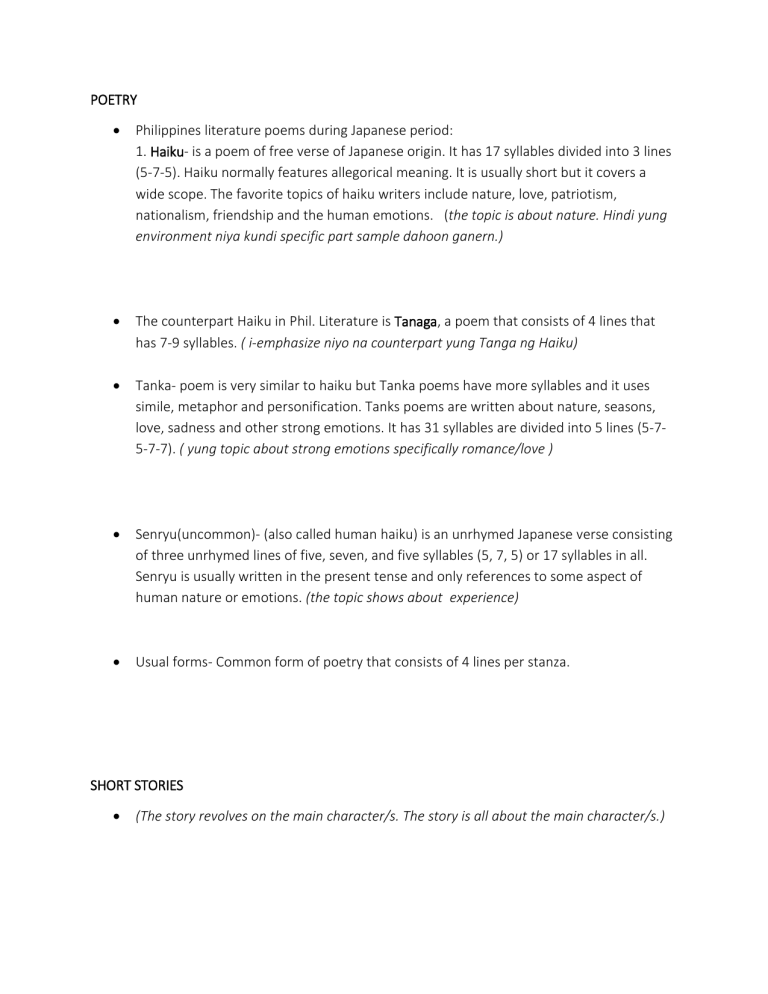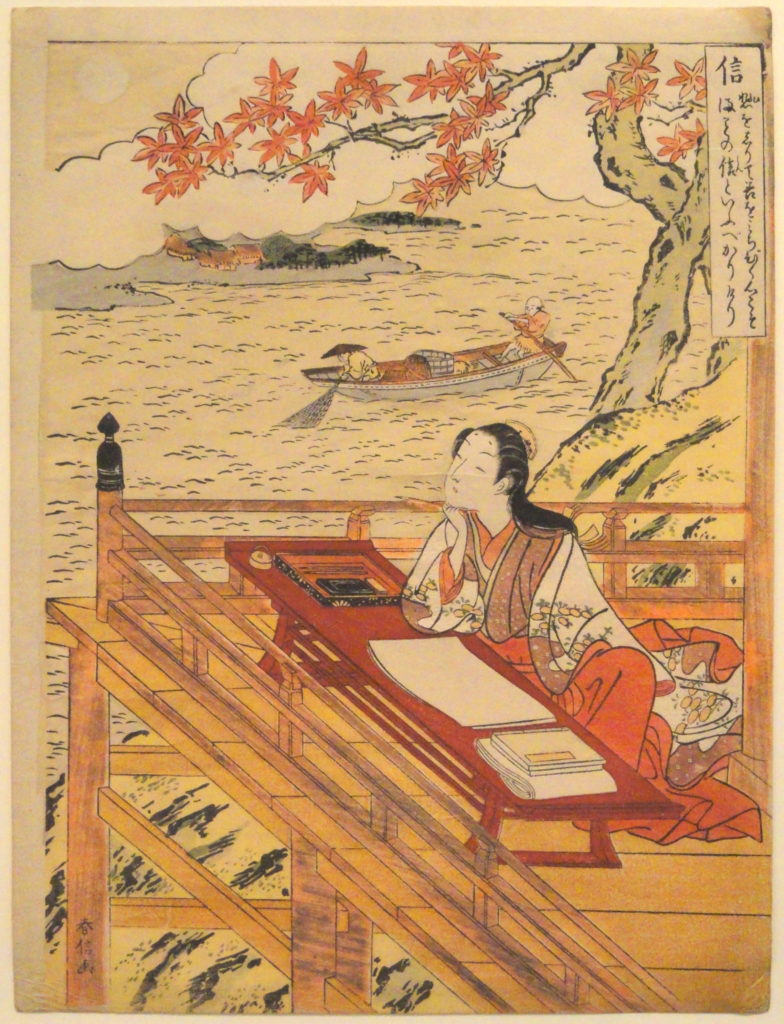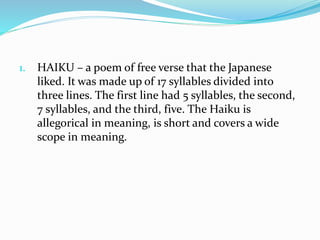Period of Enlightenment trends in writing using moden Advertisement Answer 40 5 134 venicetan014 Answer. Yosano Akiko Ishikawa Takuboku and Saitō Mokichi were probably the most successful practitioners of the new tanka.

Philippine Literature During Japanese Period
Japanese period wag na kayong mag away tao lang cya magkamali din Advertisement Advertisement.

Tanaga in japanese period. - Poetry during this time of the Third Republic were romantic and revolutionary. Tanaga Diona Dalit Tanka Haiku 1. The Filipino equivalent of a Japanese haiku is tanaga.
The Tanaga is a type of short Filipino poem consisting of four lines with seven syllables each with the same rhyme at the end of each line --- that is to say a 7-7-7-7 Syllabic verse with an AAAA rhyme scheme as in this example. Even the traditional forms tanka and haiku though moribund in 1868 took on new life thanks largely to the efforts of Masaoka Shiki a distinguished late 19th-century poet in both forms but of even greater importance as a critic. It originated in the seventh century and became the preferred form of the Japanese Imperial Court.
There were tanka contests that were put on and participate in by the nobles. The poems are not titled. Tanaga is a poem composed of four lines with each line having seven syllables written in aaaa or aabb abba or abab rhyming pattern.
Karaniwang Anyo Usual Form like those mentioned earlier in the beginning chapters of this book. HAIKU a poem of free verse that the Japanese liked. A tanaga consists of four lines with seven syllables each with a rhyme at ending each line.
The Tagalog tanaga which goes back to 1500 has been mistakenly described as the Philippine equivalent of the Japanese haiku. Tanka poetry refers to a Japanese 31-syllable poem traditionally written as a single unbroken line. Like the Japanese haiku Tanagas traditionally are untitled.
Japanese literature waka tanka in literature a five-line 31-syllable poem that has historically been the basic form of Japanese poetry. Haiku and Tanaga were influenced by what period. TANAGATANAGA Ang tanaga ay isang katutubong anyo ngAng tanaga ay isang katutubong anyo ng tula na binubuo ngtula na binubuo ng pitong pantig kadapitong pantig kada taludtodtaludtod apat na taludtod kada saknongapat na taludtod kada saknong nana may isahang tugmaanmay isahang tugmaan.
FILIPINO DRAMA DURING THE JAPANESE PERIOD. This period January 2 1981 was the Third Republic when we were liberated from Military Rule. Tanaga like the Haiku is short but it had measure and rhyme.
Tanaga have no titles. Here are some examples using the rhyme scheme AABB. Mabuti salam at The form dates back to the 16th century and has an oral tradition.
Most are handed down by oral history and contain proverbial forms moral lessons and ethics. The word tanka translates to short song Similar to haiku poetry tanka poems have specific syllable requirements. They also use many literary devices including personification metaphors and similes to allow ample visualization.
Which more broadly denotes all traditional Japanese poetry in classical forms. Below is an example of a tanaga. 21st Century Period c.
- During this period it cant be rejected that many individuals fumed with resistance and dissent in view of the proceeded with mistreatment and concealment. The Tanabata story was inspired by a famous Chinese legend. These short poems do not have any titles although the apparent.
The term tanka is synonymous with the term waka qv. FILIPINO POETRY DURING THIS PERIOD The common theme of most poems during the Japanese occupation was nationalism country love life in the barrios faith religion and the arts. Sure ka japanese bubu obvious naman sa pangalan Japanese period po ang tamang sagot.
A poetic form similar to the Tanaga is the Ambahan. Answer is B. The 3rd Republic Period.
Catitibay ca tolos sacaling datnang agos. The tanka poem is one of the oldest forms of Japanese poetry. 21st Century Period d.
Each is emotionally charged and asks a question that begs an anwer. However this varies depending on the rhyme schemes. The Tanaga is a Filipino stanzaic form that was originally written in Tagolog which to my ear is one of the more musical of languages.
Also on this site you can listen to the audio for the story. This literary period witnessed newspapers which were once branded crony newspapers become instant opposition papers. This period presented new trends in writing using modern technology.
AcoI momonting lomot sa iyoI popolopot. The Tagalog tanaga which dates back to 1500 has been referred to as the Philippine equivalent of the Japanese haiku but this is totally wrong. To compare the Japanese haiku has 17 phonetic units divided into three phrases of 5 7 and 5 units respectively.
Sumie Tanaka 田中澄江 Tanaka Sumie 11 April 1908 1 March 2000 was a Japanese screenwriter and playwright born in Tokyo. In the Old Tagalog original. A tanaga also known as luwa in Ilonggo is a pre-colonial Filipino short poetry that traditionally conveys philosophical concepts and viewpoints regarding the world events people and so on.
Bango ay todo bigay. Each line had 17 syllables and its also allegorical in meaning. - 3276399 akonalng961 akonalng961 30092020 English Senior High School.
It also includes elements of local Japanese beliefs. Tumatawag sa langit Sana ay wag ma galit Tadhanay makita Malimot pagdududa Ang pusong malimutin Sana ay baliktarin At hindi na aalis. Here is the Tanabata Story and a romaji translation.
Haiku and tanaga were influence by the what period. Three types of poems emerged during this period. Unlike the Ambahan whose length is.
She was a long-time collaborator of film director Mikio Naruse and wrote screenplays for Japans first major female director Kinuyo TanakaA member of the Bungakuza theatre company she was married to playwright and dramatist Chikao Tanaka. In Philippine literature a tanaga is a poem consisting of four lines with each line equally having between seven and nine syllables. The Tanabata story is associated with the stars Altair the Cowherd Star and Vega the Weaver Star.
Period of enlightment Advertisement Answer 31 5 38 rinamupas10 Answer.


Komentar